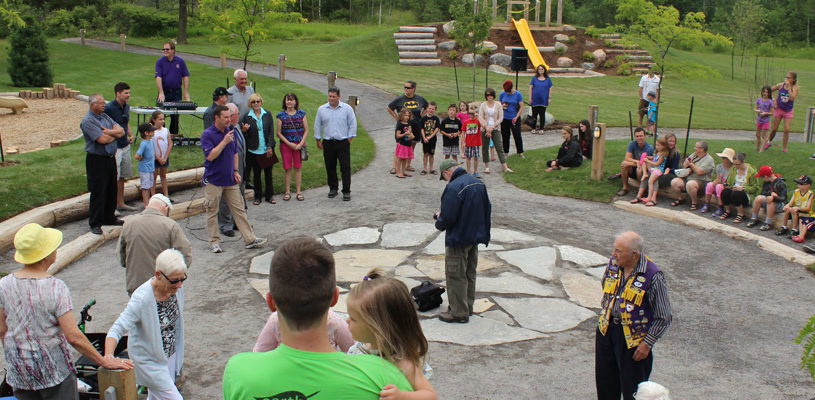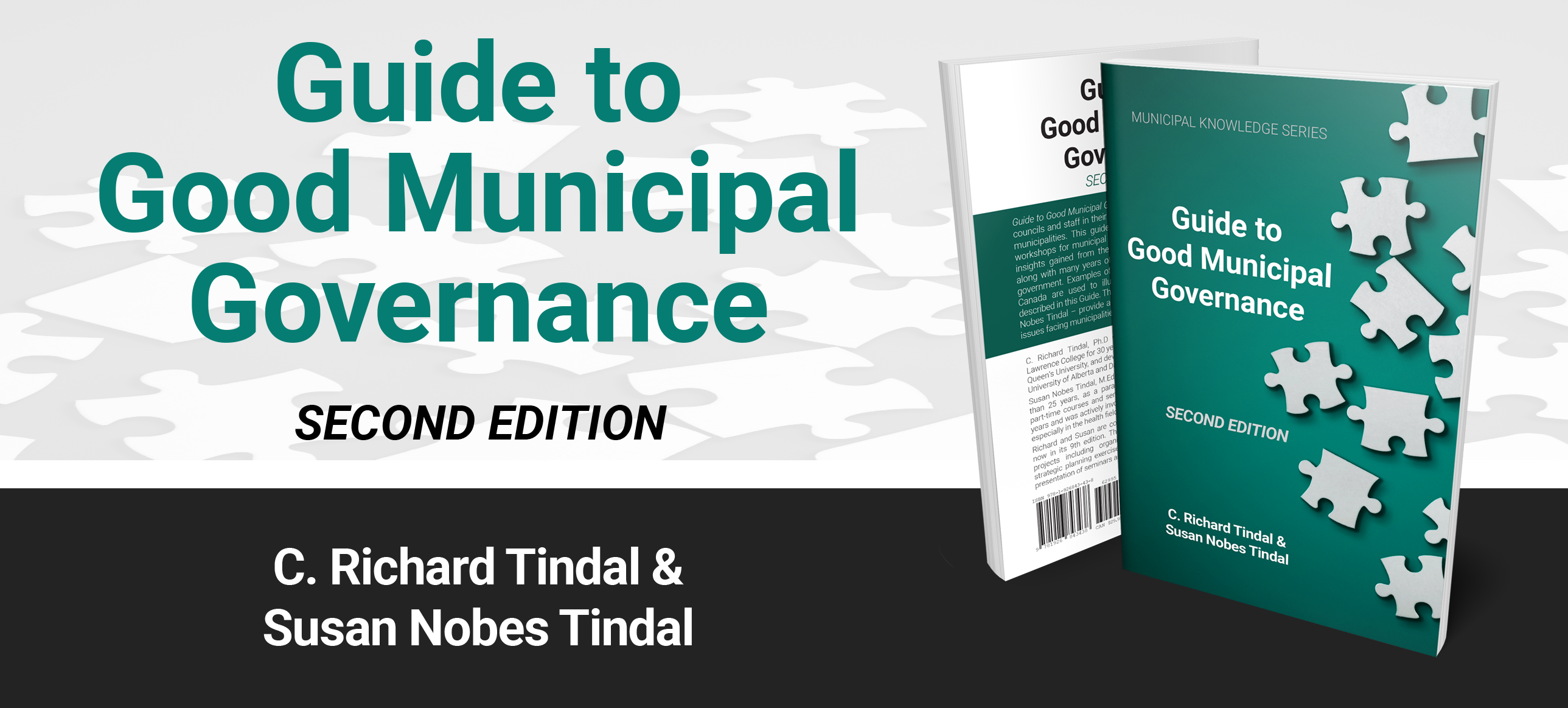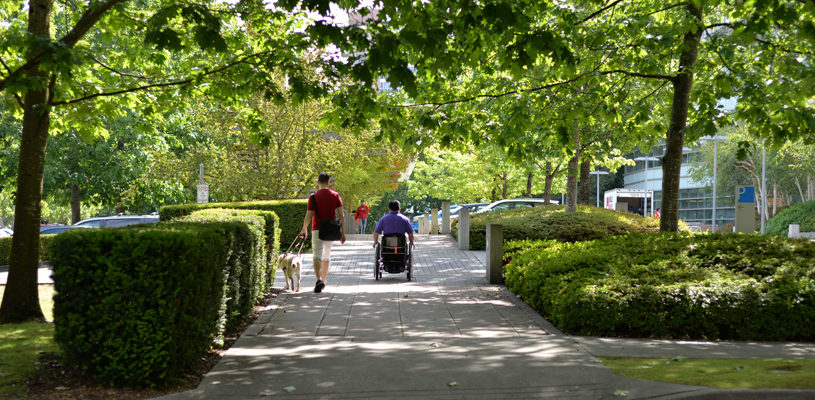A "Teeny Tiny" movement

Photo: Jeff Moorhouse (in purple Lions Club shirt with microphone) is a pilot based at CFB Trenton. Jeff has made good use of his layover time away from home to research “how to write grant proposals.” For more than five years, Jeff’s efforts in partnership with other dedicated volunteers, and a positive partnership with the municipality of Quinte West, have helped raise thousands of dollars for exciting improvements in his teeny tiny community of Batawa. A zip line is the latest addition to their state-of-the-art outdoor learning space for children five to 12 years of age. This new village asset will certainly increase Batawa’s appeal to young families.
Is there a well of new energy burbling up in some very small hamlets? Imagine a 150-year-old map of Canada. A lot of the population in the early settlement days was centred in villages that were generally within an hour or two of larger towns and cities. Many of those villages went into decline as people moved to the cities. But, now there are signs of a tangible resurgence in some of these very small rural places. These communities often have lovely heritage buildings and spacious treed parks. Many are in proximity to attractive waterways. And, the network of provincial highways means that residents are not all that far from bigger cities when an urban “fix” is needed.
Older rural settlement areas offer relatively affordable housing. They appeal to those who would like to spend less time commuting and more time close to nature, maybe getting to know their food producers first hand, or even raising their own food. More cellular towers and expanding satellite coverage, and changing workplace relationships, mean that these older hamlets and surrounding rural areas may now offer new possibilities as vibrant places to live, play, and work. Newcomers to these communities, who may be part of a small urban exodus, are connecting with seasoned long-time residents to help generate a renewed sense of vitality; and, some municipalities are figuring out how to encourage and support this teeny tiny movement.
Where it all Started
In February 2015 in the Township of Tay Valley, the local municipal planner worked with the regional economic development representative of the Ontario Ministry of Agriculture Food and Rural Affairs (OMAFRA) to foster a workshop discussion about how rural areas could boost their economies with limited resources. There was a great response to the Tay Valley session, which was attended by a mix of community development volunteers, entrepreneurs, municipal staff and elected officials, as well as others interested in community wellbeing.
Because participants made it loud and clear that they wanted to continue to network and share ideas and frustrations, local OMAFRA officials then partnered with the Township of Leeds and the Thousand Islands to host the first ever “Teeny Tiny Summit” in March 2016. Albertan Doug Griffiths was the keynote speaker, and his truth telling presentation of “13 Ways to Kill Your Community” made people cry – and laugh; but, most of all, it gave them a boost to tackle projects back in their home villages. That year, three more regional revitalization workshops for small places happened in Maynooth, Alvinston, and Neustadt. As a similarly-themed session at the annual Association of Municipalities of Ontario conference in Windsor in August 2016 kindled more interest in the topic. In June 2017, two more Teeny Tiny Summits were held, in Havelock and Merrickville respectively, with guest speaker Peter Kenyon, the Australian rural revitalization guru from Bank of I.D.E.A.S. Kenyon shared stories of success economic turnarounds in places with less than 300 residents; and, just like Griffiths, he inspired with humour, truth, and very practical tips. Sharing great ideas for others to steal and adapt is encouraged at these sessions. Kenyon shared a story of a small village of less than 200 in Australia that has become a significant visitor destination because they created a nighttime roving street theatre where local residents volunteer to portray historic characters who are buried in the local cemetery. Visitors pay $70 for dinner and the street tour, and the revenues from the busloads of visitors have helped stimulate the creation of the first Indigenous sports hall of fame in the hamlet, and more.
Over 600 people have now attended one of these Teeny Tiny Summits, and more communities are asking to host future sessions to continue to the learning. OMAFRA regional economic development consultants are seeing a lot of energy and appetite for rural development support and tools that are relevant to the smallest of communities. Canada is mostly made up of small places in lower-density population areas, and many of these places have assets with renewed potential in the context of evolving economic conditions.
.jpg)
“Seeley’s Bay Steps Up” has had a significant impact on raising the profile of this hamlet in the Township of Leeds & the Thousand Islands. The local Residents’ Association lead the process starting with an asset-based analysis of potential, followed by broad consultations, the development of a comprehensive strategic plan, and fundraising; the municipality encouraged the work, issued charitable tax letters to donors, oversaw construction tenders, and fulfilled financial reporting duties where required.
Emerging Themes
The themes that must be addressed to support this micro-development approach, both from a policy and practical level, are beginning to emerge. In places that lack the conventional capacity and/or scale normally associated with economic development initiatives, the ingredients that seem to overcome those challenges include an appreciation for small steps, realistic asset mapping, smart planning, respectful municipal-voluntary collaboration, a willingness to try new approaches and emerging technologies, great story-telling capacity, and a positive attitude.
Harnessing the power of volunteer groups – Rural municipalities are often challenged to accomplish the basics of road maintenance and public safety – due to limited staff resources and strained budgets. In these circumstances, an eager group of volunteers who are determined to do something about “their” village, right now, can sometimes be seen as a pain in the neck. On the other hand, those volunteers may well have skills and resources that can bring significant benefits to the municipality, if each party can take time to learn about the constraints and possibilities that each can bring to the effort. Volunteers often have the networks and passion to achieve a great deal. They can consult residents, develop plans, raise funds, and offer skilled and unskilled labour. Municipalities can incorporate such local plans into budgets over the long term; sometimes, they can offer staff assistance; they can often help address insurance and liability barriers; and political leaders can champion and encourage local hamlet energy.
Small projects matter – Funders sometimes find it tough to “think small.” Traditional economic development grants seek out projects that will generate impressive job creation numbers. But, in a teeny tiny place, the first step toward becoming a destination of interest might be a single public toilet. If a visitor is 30 minutes away from the closest public facility, there is little chance they will linger to visit a shop or read your historical interpretive signs.
Need for big data – Reliable information can be harder to sort out for small places, too. Most public data is based on census areas that embrace a much wider area than the specific hamlet, and that leads to the risk that local volunteers can be overly reliant on the long-held impressions of what works/does not work, and by their own sense of who lives in the area and what they want. But, new work is underway to help liberate big data for small places, and even volunteers, using a door-to-door clipboard may be able to get an up to date and more accurate picture of population needs and interests.
Micro-communal water systems – Water and wastewater servicing is another classic challenge for small places, and it can be a game changer in terms of allowing/killing any growth potential. But, emerging technologies, and a willingness to modernize regulations, have to potential to see micro-communal systems in small places, which may no longer require big pipe, village wide upheaval, and unattainable budgets.
Keeping Inspiration Alive
The passion of residents for the place they live may be the most important factor of all in this teeny tiny movement. And, how to keep the passion alive over a sustained period, while the hard work of planning and doing goes on, may also be something that can be learned from others, shared, and adapted. Having a great storyteller as part of your team can go a long way to keeping inspiration alive.
In tiny Queensborough, in Peterborough County, urban escapee Kathrine Sedgwick has created a big following on her blog “Meanwhile at the Manse” . Her blog is bringing visitors to the hamlet and it helped to motivate energy to fight a rural school closure. The next key bit of economic development for the “Queensboroughs” of rural Ontario might just be a single public toilet so that visitors can linger.
Bridges, subways, and airports might be the infrastructure requirements for big cities; but, for teeny tiny places, “small is beautiful.” MW
|
What is a Teeny Tiny place?
|
LIZ HUFF is a municipal councillor for the Township of Leeds & the Thousand Islands and the volunteer leader of Seeley’s Bay Steps Up. Liz also serves on the Board of the Association of Municipalities of Ontario and the Rural Ontario Municipal Association.
as published in Municipal World, September 2017



